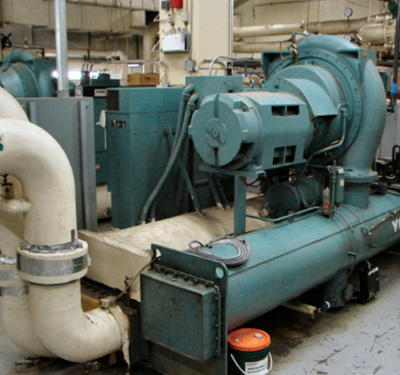

A Perfectly Engineered Answer to a Common Chiller Question
Posted by Bob Schneider on in Engineering
TES Engineering recently had the opportunity to oversee a chiller replacement at a national retail anchor store. Because of the Landlord/Tenant Agreement, the mall was responsible for replacing the chiller and bore the cost of the installation, but the tenant is responsible for operating costs.
This type of agreement raises a question:
Should the mall select the most energy efficient chiller or the most cost effective chiller?
Keep in mind: chillers represent the single largest electric load in the facility, accounting for 30 to 50 percent of the electricity usage.
To answer the question, let’s first look at the industry standard when the building’s original chiller was installed. 1990s technology produced chillers with a peak efficiency of 0.75 to 0.85 kilowatts per ton (Kw/ton). Even with normal usage and good maintenance, these efficiencies can reduce to 0.80 to 1.0 Kw/ton.
Manufacturers are currently producing chillers with efficiencies of 0.49 to 0.60 Kw/ton.
Second, let’s look at refrigerants. The original chiller used refrigerant R11, which has proved to be an ozone depleting CFC and is no longer produced. Chiller
manufacturers currently use HCFC 123 and HCFC 134a, both of which are far more environmentally friendly (and produced).
A third point to consider is the partial load efficiency. Chillers normally only operate at fullload capacity 2% of the time over the course of a year. This means 98% of the time, a chiller will operate between 20% and 75% capacity a fraction of the fullload performance.
As engineers, we need to balance the metric of fullload efficiency and operating efficiencies. The use of variable frequency drives, variable pitch vanes, and screw chillers offer a multitude of choices for the replacement chiller.
Fourth, let us analyze price. For each 0.01 Kw/ton improvement in chiller efficiency, the first cost may increase by $12,000. An operational savings of $4,000 per year offsets this price increase and means the payback is 3 years and an operation savings of
$100,000 over the 25year life of the chiller.
Taking into consideration all of these items, what is the final answer?
Each chiller replacement should determine a perfect balance of first cost, operating cost, operating hours, and environmental performance. Engineers have the tools and experience to analyze existing equipment and construct a building model to find a perfectly engineered solution.

 Previous STORY
Previous STORY